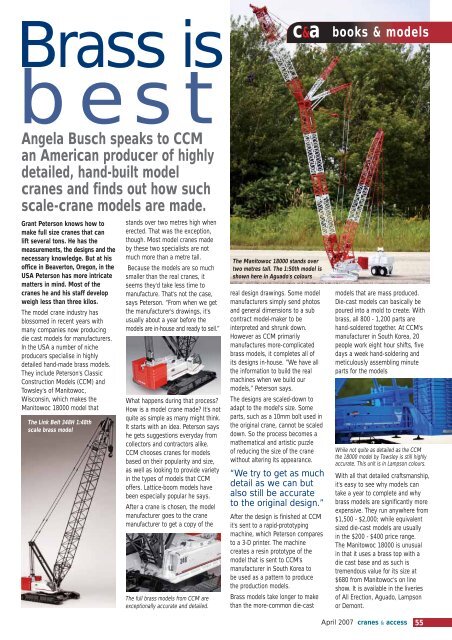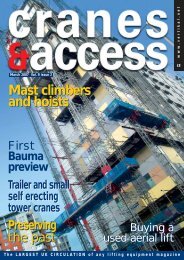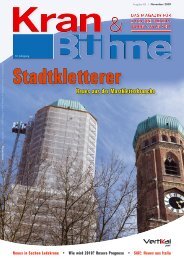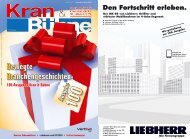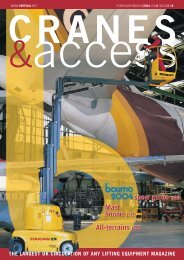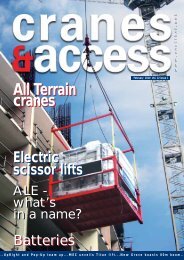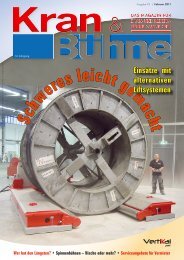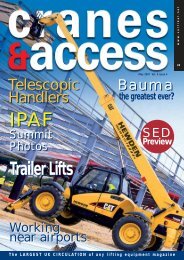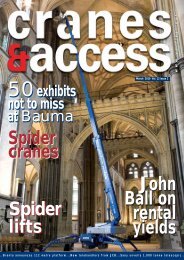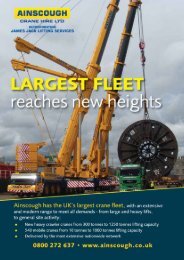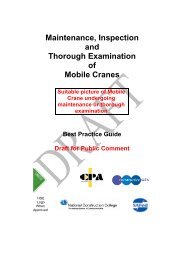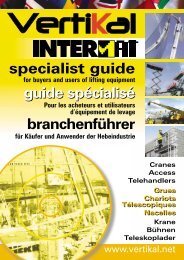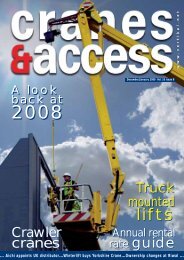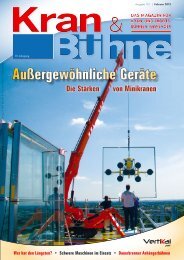Bauma Bauma
Bauma Bauma
Bauma Bauma
You also want an ePaper? Increase the reach of your titles
YUMPU automatically turns print PDFs into web optimized ePapers that Google loves.
Brass is<br />
best<br />
Angela Busch speaks to CCM<br />
an American producer of highly<br />
detailed, hand-built model<br />
cranes and finds out how such<br />
scale-crane models are made.<br />
Grant Peterson knows how to<br />
make full size cranes that can<br />
lift several tons. He has the<br />
measurements, the designs and the<br />
necessary knowledge. But at his<br />
office in Beaverton, Oregon, in the<br />
USA Peterson has more intricate<br />
matters in mind. Most of the<br />
cranes he and his staff develop<br />
weigh less than three kilos.<br />
The model crane industry has<br />
blossomed in recent years with<br />
many companies now producing<br />
die cast models for manufacturers.<br />
In the USA a number of niche<br />
producers specialise in highly<br />
detailed hand-made brass models.<br />
They include Peterson's Classic<br />
Construction Models (CCM) and<br />
Towsley's of Manitowoc,<br />
Wisconsin, which makes the<br />
Manitowoc 18000 model that<br />
The Link Belt 348H 1:48th<br />
scale brass model<br />
stands over two metres high when<br />
erected. That was the exception,<br />
though. Most model cranes made<br />
by these two specialists are not<br />
much more than a metre tall.<br />
Because the models are so much<br />
smaller than the real cranes, it<br />
seems they'd take less time to<br />
manufacture. That's not the case,<br />
says Peterson. “From when we get<br />
the manufacturer's drawings, it's<br />
usually about a year before the<br />
models are in-house and ready to sell.”<br />
What happens during that process?<br />
How is a model crane made? It's not<br />
quite as simple as many might think.<br />
It starts with an idea. Peterson says<br />
he gets suggestions everyday from<br />
collectors and contractors alike.<br />
CCM chooses cranes for models<br />
based on their popularity and size,<br />
as well as looking to provide variety<br />
in the types of models that CCM<br />
offers. Lattice-boom models have<br />
been especially popular he says.<br />
After a crane is chosen, the model<br />
manufacturer goes to the crane<br />
manufacturer to get a copy of the<br />
The full brass models from CCM are<br />
exceptionally accurate and detailed.<br />
c&a<br />
The Manitowoc 18000 stands over<br />
two metres tall. The 1:50th model is<br />
shown here in Aguado's colours<br />
real design drawings. Some model<br />
manufacturers simply send photos<br />
and general dimensions to a sub<br />
contract model-maker to be<br />
interpreted and shrunk down.<br />
However as CCM primarily<br />
manufactures more-complicated<br />
brass models, it completes all of<br />
its designs in-house. ”We have all<br />
the information to build the real<br />
machines when we build our<br />
models,” Peterson says.<br />
The designs are scaled-down to<br />
adapt to the model's size. Some<br />
parts, such as a 10mm bolt used in<br />
the original crane, cannot be scaled<br />
down. So the process becomes a<br />
mathematical and artistic puzzle<br />
of reducing the size of the crane<br />
without altering its appearance.<br />
“We try to get as much<br />
detail as we can but<br />
also still be accurate<br />
to the original design.”<br />
After the design is finished at CCM<br />
it's sent to a rapid-prototyping<br />
machine, which Peterson compares<br />
to a 3-D printer. The machine<br />
creates a resin prototype of the<br />
model that is sent to CCM's<br />
manufacturer in South Korea to<br />
be used as a pattern to produce<br />
the production models.<br />
Brass models take longer to make<br />
than the more-common die-cast<br />
books & models<br />
models that are mass produced.<br />
Die-cast models can basically be<br />
poured into a mold to create. With<br />
brass, all 800 - 1,200 parts are<br />
hand-soldered together. At CCM's<br />
manufacturer in South Korea, 20<br />
people work eight hour shifts, five<br />
days a week hand-soldering and<br />
meticulously assembling minute<br />
parts for the models<br />
While not quite as detailed as the CCM<br />
the 18000 model by Towsley is still highly<br />
accurate. This unit is in Lampson colours.<br />
With all that detailed craftsmanship,<br />
it's easy to see why models can<br />
take a year to complete and why<br />
brass models are significantly more<br />
expensive. They run anywhere from<br />
$1,500 - $2,000; while equivalent<br />
sized die-cast models are usually<br />
in the $200 - $400 price range.<br />
The Manitowoc 18000 is unusual<br />
in that it uses a brass top with a<br />
die cast base and as such is<br />
tremendous value for its size at<br />
$680 from Manitowoc's on line<br />
show. It is available in the liveries<br />
of All Erection, Aguado, Lampson<br />
or Demont.<br />
April 2007 cranes & access 55


